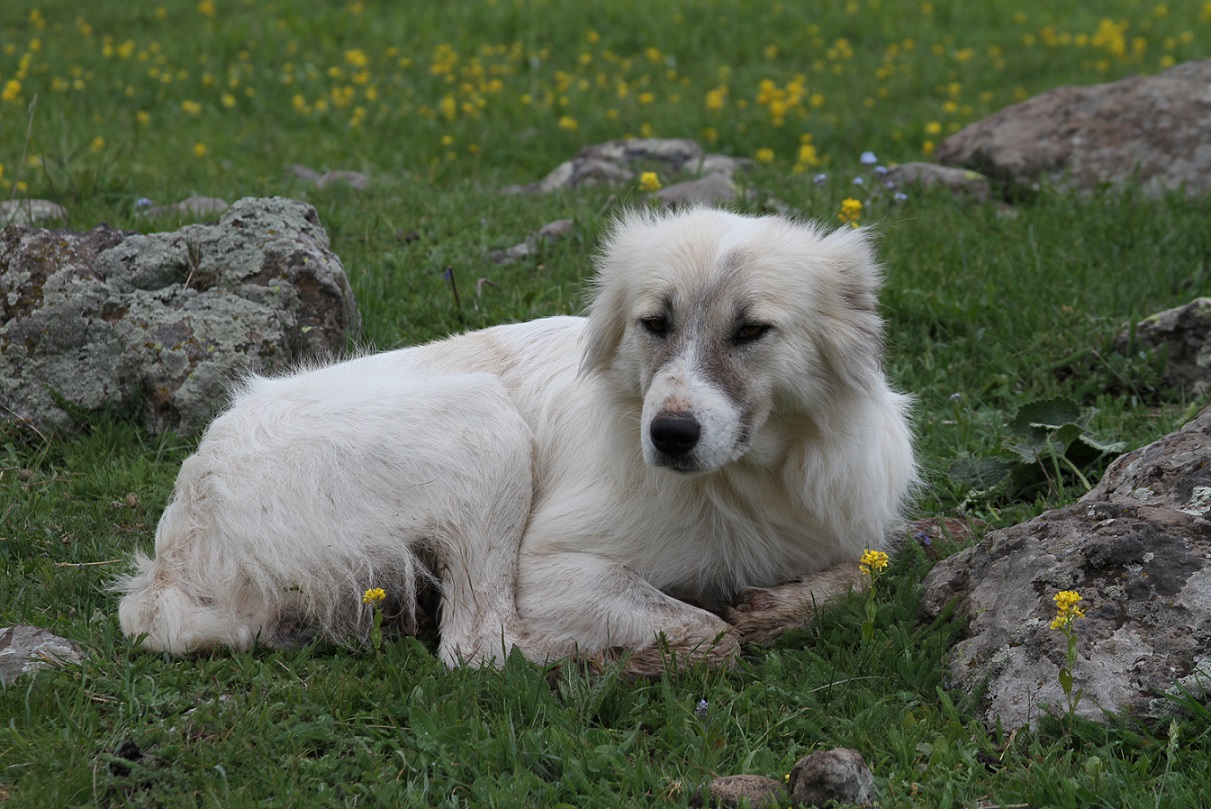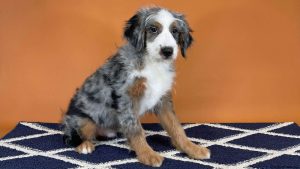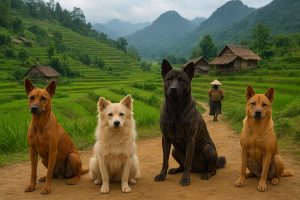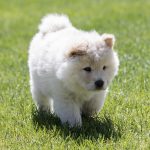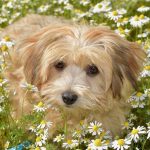Among all the livestock guardian dog (LGD) breeds, there’s something truly special about the Armenian Gampr; a breed that carries thousands of years of history in its blood and a presence that commands both respect and admiration. People often ask, “What makes the Gampr different from other LGDs like the Kangal or Great Pyrenees?”
The answer, in short, lies in the Gampr’s roots; untouched by modern breeding trends and still deeply connected to its original purpose: guarding livestock and protecting life in its purest form.
In this comprehensive guide, we’ll delve into everything you need to know about the Armenian Gampr: its origins, temperament, physical characteristics, suitability, training requirements, and what life with one of these majestic dogs is truly like.
Table of Contents
Quick Breed Profile
Origin: Armenia (Caucasus Mountains)
Group: Livestock Guardian Dog
Size: 90–140 lbs (41–64 kg)
Lifespan: 12–15 years
Temperament: Calm, loyal, protective, independent
Best suited for: Farms, ranches, or large rural properties
Key traits: Natural guardian, low prey drive, quiet strength
History of the Armenian Gampr
To truly understand a breed, you have to go back to where it began.
The Armenian Gampr is one of the oldest known livestock guardian breeds in the world, native to the Armenian Highlands, a rugged and mountainous region that shaped both the people and the dogs who lived there.
Historical evidence and archaeological records suggest that dogs resembling today’s Gampr existed over 4,000 years ago. Petroglyphs found in ancient Armenian sites depict large, powerful dogs standing alongside shepherds, a silent testament to the Gampr’s enduring role as a protector of flocks and families.
Unlike many breeds that were refined through selective breeding for looks or show standards, the Gampr remained a landrace breed, meaning it evolved naturally through function, not fashion. For centuries, these dogs survived based on performance, adaptability, and instinct rather than color or body measurements. Each generation was shaped by the harsh environment of the Caucasus Mountains: extreme temperatures, predators, and long working hours among shepherds.
When you breed or raise a Gampr today, you’re not just working with a dog; you’re preserving a living piece of history.
Appearance and Physical Traits
One of the first things people notice when meeting an Armenian Gampr in person is its imposing yet calm presence. These dogs are large and muscular, but not exaggerated. They are powerful, yet every ounce of their strength serves a purpose.
Size and Proportion
Males: Typically 26–30 inches (65–75 cm) at the shoulder, weighing between 100–140 pounds (45–63 kg).
Females: Slightly smaller, averaging 24–28 inches (60–70 cm) and 90–120 pounds (40–54 kg).
They have a balanced, athletic frame, with a body slightly longer than tall, ideal for covering long distances across pastures or rocky terrain.
Coat and Colors
Gamprs have a dense double coat, perfectly suited to Armenia’s diverse climate: cold winters, warm summers, and everything in between.
- The undercoat is soft and insulating.
- The outer coat is coarse and water-resistant.
Coat length varies from short to long depending on regional adaptation. Working Gamprs often develop a thicker, medium-length coat when raised in colder or mountainous environments.
Acceptable colors include a wide variety: fawn, sable, cream, brindle, and even darker shades with or without masks. This variety is typical of landrace breeds. What matters most is not color, but sound temperament, strong structure, and reliable guarding instinct.
Head and Expression
The head of the Gampr is large but proportionate to the body, with a broad skull, powerful jaw, and thoughtful, deep eyes.
Their expression reflects intelligence, calm awareness, and confidence, the look of a dog that’s always observing but never panicking.
Temperament:
If there’s one trait that defines the Armenian Gampr, it’s independent intelligence.
Unlike obedience breeds that constantly seek human direction, the Gampr was bred to think for itself. When working alone in remote mountains, it couldn’t rely on human instructions; it had to evaluate threats, make decisions, and act decisively.
Protective Instincts
Gamprs are born protectors. Their instinct to guard is not taught; it’s inherited.
They naturally form a bond with their flock or family and will protect it with quiet confidence. They are not overly aggressive but will not hesitate to confront a real threat.
A true Gampr is balanced: calm, alert, and courageous.
It doesn’t bark without reason, and it doesn’t attack out of fear. Its confidence comes from centuries of selective survival, not forced training.
With Family and Children
When raised correctly, Gamprs are deeply loyal and affectionate with their families. They tend to be gentle with children and tolerant of other pets, especially when introduced early.
However, their protective drive means they must be socialized properly. They may not welcome strangers easily, and that’s part of what makes them excellent guardians.
With Other Animals
Gamprs coexist beautifully with livestock when raised around them from a young age. They see the herd as part of their “family unit.” Whether it’s sheep, goats, or even chickens, they instinctively know how to protect without harming.
Socialization and early exposure are key. These dogs don’t just learn obedience; they understand context, judgment, and boundaries through consistent experience.
Training and Socialization:
Training a Gampr is unlike training most dog breeds. They don’t respond to repetitive commands or rigid obedience routines. Instead, they respond to mutual respect, calm authority, and consistent exposure to their environment.
Here are a few practical tips for new Gampr owners:
1. Start Early
Begin socialization from 8 weeks old. Introduce your puppy to livestock, people, and different sounds. Early familiarity reduces the risk of overprotectiveness later on.
2. Teach Boundaries, Not Tricks
Gamprs are intelligent enough to learn commands like “stay,” “come,” and “leave it,” but the focus should be on developing trust and respect rather than robotic obedience.
They must understand who their leader is, but still be allowed to think independently.
3. Avoid Harsh Discipline
Dominance-based training or punishment does not work with this breed. Gamprs respect fair, confident leadership but will shut down or become distrustful under harsh correction.
4. Provide Purpose
These dogs thrive when they have a role, whether guarding livestock, watching over property, or accompanying you during outdoor activities. A bored Gampr can become stubborn or destructive.
5. Gradual Introductions
When meeting new people or dogs, slow and structured introductions are best. Their protective instincts can be strong, especially during adolescence.
Health, Lifespan, and Care
Because the Armenian Gampr developed naturally as a working landrace, it remains a generally healthy breed with minimal genetic disorders compared to many modern dogs.
Common Health Considerations
- Hip and elbow dysplasia: As with all large breeds, screening parent dogs is essential.
- Bloat (gastric torsion): Feed two smaller meals instead of one large one and avoid intense activity right after eating.
- Joint health: Controlled growth and a balanced diet in the first 18 months are critical.
Lifespan
Gamprs typically live between 12–15 years, which is excellent for a dog of their size. Proper diet, exercise, and living conditions play a major role in their longevity.
Grooming Needs
Despite their thick coats, grooming is straightforward:
- Brush weekly to prevent matting.
- Bathe occasionally (too frequent bathing removes natural oils).
- Expect heavy shedding twice a year.
- Regular nail trimming and ear checks are essential.
Ideal Living Environment for an Armenian Gampr
Gamprs are not suitable for small apartments or urban living.
The ideal home for a Gampr includes:
- A farm, ranch, or large property with secure fencing.
- Livestock or an outdoor area where the dog can have a purpose.
- An owner or family who appreciates independence and working instincts.
Gamprs need space to roam, patrol, and observe. They are happiest when they have responsibility, even if that’s simply guarding a large property or staying close to family outdoors.
If you live in a suburban or rural home without livestock, you can still raise a Gampr successfully, but you’ll need to offer mental engagement, long walks, property guarding, and consistent social contact.
Difference Between the Armenian Gampr and Other LGDs
The Armenian Gampr holds a unique place among Livestock Guardian Dogs (LGDs) because it is considered an ancient, aboriginal landrace breed, meaning its characteristics were shaped by natural selection in its native highlands for thousands of years, rather than a fixed standard developed by human breeding.
Here is a comparison of the Gampr to some of its closest cousins:
Gampr vs. Kangal Shepherd Dog
The Gampr is distinguished as a true landrace, exhibiting a high degree of natural genetic variation in color, coat, and build; the Kangal, in contrast, is a standardized breed with a more consistent, often solid tan or sable coat and a black mask. Historically, many of the modern Turkish LGDs, including the Kangal, are believed to have developed from pockets of the ancient Gampr population native to the Armenian Highlands. Check out the detailed comparison between a Gampr and the Kangal.
Gampr vs. Caucasian Shepherd Dog (Ovcharka)
The Gampr is the original dog of the South Caucasus, known for its keen intellect and measured, rational protection style; the modern Caucasian Ovcharka is a more recent, standardized breed developed heavily under Soviet influence, often including cross-breeding with dogs like the St. Bernard and German Shepherd to create a more heavy-boned, sometimes more reactive dog.
Gampr vs. Anatolian Shepherd Dog
The Gampr remains a diverse, naturally adapted dog whose structure prioritizes function and endurance over uniform looks; the Anatolian Shepherd Dog is a distinct, standardized breed that was developed outside of Turkey (primarily in the U.S.) from regional Turkish LGDs, and today exhibits a more slender, often slightly smaller build than a traditional Kangal.
Gampr vs. Maremma Sheepdog
The Gampr is traditionally a physically robust dog of diverse colors and coats, built for the harsh, high-altitude terrain of Armenia and known for serious, independent judgment in dealing with threats; the Maremma, originating from the milder central Italian plains, is a strikingly beautiful, uniformly white dog known for its deeply protective nature and often favored for flocks in more settled agricultural regions.
Choosing the Right Breeder:
The Armenian Gampr is a rare breed, especially outside Armenia, and its preservation depends heavily on ethical breeders who respect its origins and purpose.
When searching for a breeder:
- Ask if the dogs are working lines, raised around livestock or used as actual guardians.
- Request health clearances for hips and elbows.
- Look for breeders who emphasize temperament and working ability over appearance.
- Ask how their puppies are socialized; are they raised outdoors, exposed to livestock, and handled daily?
- Avoid anyone selling Gampr “mixes” or “extra-large Gamprs” for commercial gain. Authenticity matters.
It’s really important to protect the legacy of the breed, preserving its instincts, structure, and balance of mind.
Why the Armenian Gampr Is Special
After closely analyzing various LGD breeds, from Kangals to Great Pyrenees, it can openly be said that the Armenian Gampr has a unique personality that stands apart.
- It’s more self-assured than most guardian breeds, rarely anxious or loud.
- It possesses a calm strength, a quiet awareness that commands respect without aggression.
- It maintains true working versatility, equally devoted to livestock and family.
- And above all, it has a sense of honor, a natural dignity that reflects its deep heritage.
Gamprs aren’t dogs you “own.” They are partners. They’ll challenge you to be a calm, confident leader, and in return, they’ll give you unwavering loyalty.
Final Thoughts:
Owning or breeding an Armenian Gampr is not just about having a dog: it’s about carrying forward a legacy and an ancient relationship between human and guardian.
If you’re considering this breed, take the time to learn about its history, temperament, and working nature. Understand that this is not a breed for everyone, but for the right person, it is everything a guardian should be: loyal, wise, strong, and steadfast.
For farmers, ranchers, and responsible owners looking for an authentic guardian, the Armenian Gampr is not just a dog; it’s a legacy that lives and breathes beside you.

